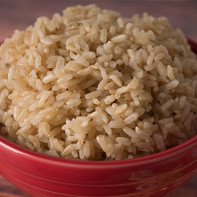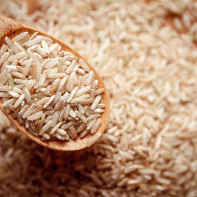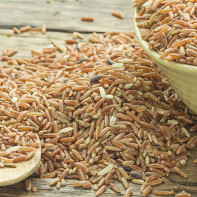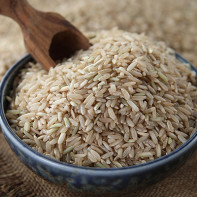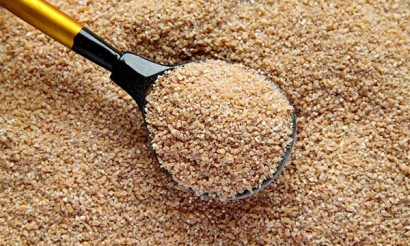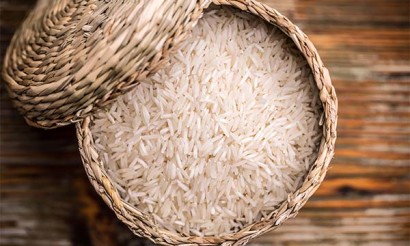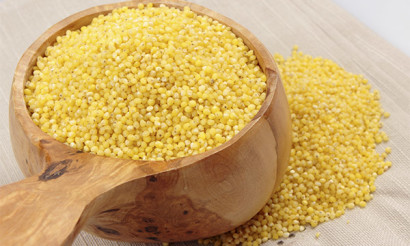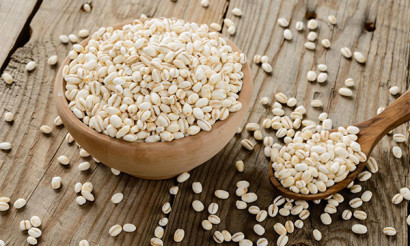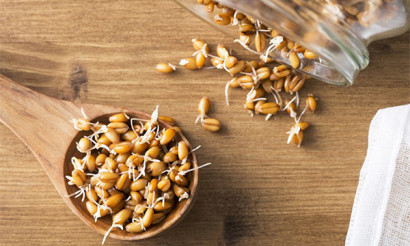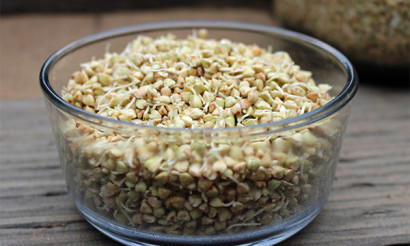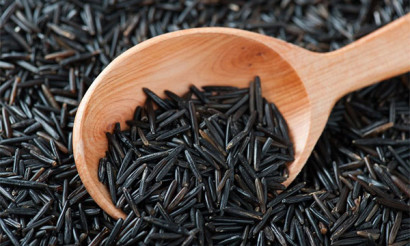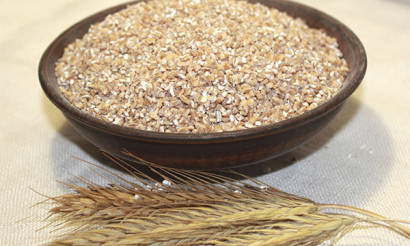Brown rice: useful properties and recipes for cooking
Many modern diets include unfamiliar still for our lands kargo groats, or brown rice.Those who seek to lose weight, began to be interested in a new way: experts say that brown rice saturates the body with vitamins and helps to effectively cleanse the body. Let's talk more about the benefits and harms of brown rice, as well as consider some interesting recipes.
- How brown rice differs from ordinary rice
- Composition and Calories
- Glycemic Index of Brown Rice
- What is brown rice good for the body?
- Can Children eat Brown Rice?
- Useful properties of brown rice for weight loss
- Brown rice in medicine
- Diabetes
- For pancreatitis
- Gastritis
- For constipation
- In gout
- Recipes of folk medicine based on brown rice
- Harm and Contraindications
- How to Boil Brown Rice: Recipes
- How to choose and store brown rice
How brown rice differs from conventional rice
First of all about brown rice you need to know that this is the most common cultivated rice, which we are used to seeing on our tables. Its difference from white groats is not in the variety or specific coloring, but only in the fact that brown grain is not ground. However, this small difference carries a lot of significant changes in its composition.
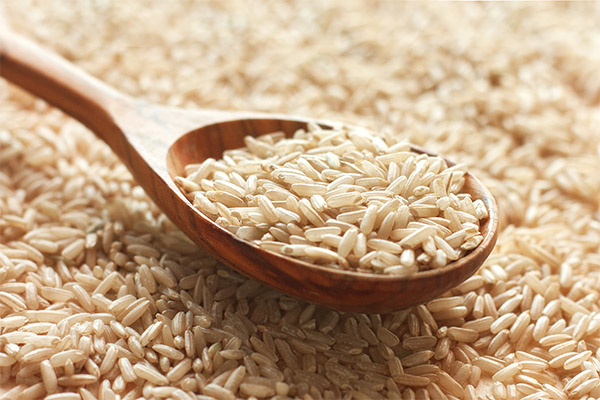
Ordinary white rice, after extraction from the spikelets, is peeled of scales, bran and germ are removed, after which a starchy and useful cereal reaches us in the food. Brown rice is not cleaned and polished, so the groats turn out bran: it has much more protein, useful dietary fiber and vitamins, which are accumulated in the shell of the grain. Such groats saturate the body well and contribute to weight loss, if you use it correctly, observing a few rules, which will be discussed below.
Brown rice is very common in the cuisines of Asian and southern countries, and is also found in Mexican food. Like all foods, it is not completely safe for the body and requires specific processing and rationed consumption to bring health benefits. Proper preparation makes it a valuable source of nutrients, and in addition, we should not forget about its unique delicate flavor and aroma.
Well-cooked brown rice has a delicate nutty flavor and subtle sweetness; some varieties have a distinctly fruity taste, so it goes well with both salty dishes and desserts, and is delicious not only when warm, but also after cooling. It is most frequently added to side dishes with vegetables, combined with fish and chicken or made into fruit porridge. Brown rice also makes excellent casseroles and stews.
This light and nourishing cereal is ideal for diet menus with a balanced composition. Many thinners note as a plus its taste: there is no feeling that on a diet you are deprived of delicious food. Nevertheless, many nutritionists and cooks point out that the difference between brown and white rice is not great, so there is no need to cut out the usual porridge from your diet. It is enough to alternate between different side dishes to maintain a healthy and diverse diet.
Composition and calories
Thanks to the fact that brown rice retains the protein germ and bran, its caloric value is somewhat reduced, but the nutritional value increases. It contains about 330-360 kcal per 100 g, 7,5 g of protein, up to 2 g of fat and more than 75 g of carbohydrates.
Cereal combines all the value of white rice and the benefits of its bran, having in its composition:
- calcium, magnesium, iron, copper, zinc, manganese, sodium, phosphorus, iodine, selenium;
- vitamins of groups B, PP, K, H, E;
- antioxidants, sorbents;
- valuable amino acids and useful fatty compounds.
One important factor for allergy sufferers is that rice has no gluten or gluten, which often irritates the intestines and impairs absorption in many people.
Nevertheless, you should be aware that raw rice contains poisonous substances that serve to protect the grain from external influences. This is why it is very important to properly process and cook the cereal in order to take out all the excess, leaving only the useful components.
It is recommended to eat no more than 200 grams of cooked porridge a day for adults and 250 grams for men. At the same time it is recommended to eat brown rice not very often: up to 2-3 times a week or during unloading. There are also various methods of health improvement:
- arrange cleansing days on one rice;
- 3 to 5-7 day diets;
- Detox lunches after a night out or drinking alcohol.
Brown rice is recommended for children's diets and the elderly, introduced into the diet for medical reasons. Let's further consider what exactly brown rice is useful for and how it helps to heal the body.
Glycemic Index of Brown Rice
The glucose increase index of brown groats is equal to 45-50 units. This means that such porridge can be consumed in case of diabetes. It should be said that any cereal that carries a large supply of carbohydrates will raise blood glucose, so you should eat such dishes with caution. However, compared to many cereal brethren, brown rice is one of the least difficult cereals for the pancreas.
Moderate consumption helps to normalize blood sugar levels, avoid its spikes and drops, maintain satiety for several hours and eliminate the nervous feeling of hunger. The glycemic index of the product is important not only for diabetics. This indicator should also be taken into account when formulating a proper dietary, children's, work, and sports diet.
Products with a high GI index contain quickly degradable carbohydrates. Therefore blood sugar levels from them rises sharply, but after a short time falls, and the body wants to eat again. A low GI indicates that the product is digested slowly, gradually saturating the body. In combination with swelling fiber, such food provides a feeling of fullness for a long time: the body is busy digesting and does not require snacks.
On diets, this property will help to lose weight, not to overeat, allow the digestive system to recover from illness without overloading the body. In sports, children's and work diets, it will maintain energy boost for several hours, without awakening feelings of fatigue and lethargy. It also helps to calm the nervous system and not think about food all the time.
Brown rice has a combination of vitamins and minerals, valuable dietary fiber, amino acids and "long" carbohydrates to stay awake and active all day long. At the same time the product is very palatable. In the diet of diabetics and thinners, it will be an excellent base for desserts with dried fruit without any harm to health.
What is brown rice good for your body
Brown rice, or kargo, is rich in valuable components, thanks to which it has a beneficial effect on the body:
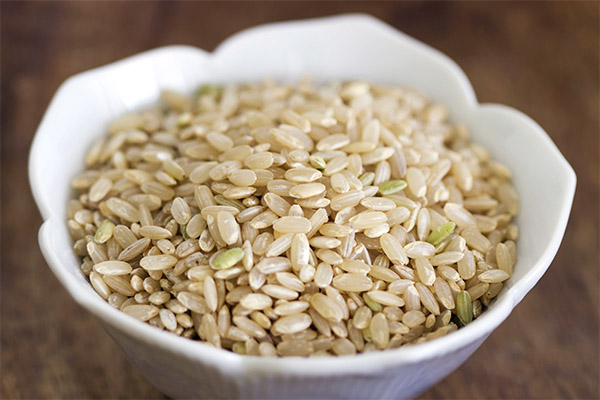
- It normalizes the nervous system, relieves signs of stress and chronic fatigue, and strengthens cells.
- Participates in blood formation, preventing the development of anemia and speeding up the process of blood circulation, which contributes to the rejuvenation, weight loss and proper functioning of the entire body.
- It strengthens bones and stimulates the development of the muscular system and increases the elasticity of tissues.
- Cleanses the intestines and eliminates toxins, gives a binding effect, normalizes the absorption of useful substances.
- Enhances the antioxidant effect, preventing the action of carcinogens and radicals.
- Supports the health of nails and hair, makes the skin supple, contributing to the saturation of cells with moisture.
- It stimulates the immune system.
- Promotes rejuvenation and renewal of the body.
- Helps to remove fluid from the body and edema.
- Participates in the normalization of reproductive function in men and women.
- Eliminates signs of diarrhea and intoxication.
- Increases stamina and performance.
The product is considered dietary and useful compared to other porridges due to the bran content, absence of allergenic proteins, reduced carbohydrate content, as well as valuable vitamin complex.
Of course, brown rice is not a panacea. You can happily eat it for variety and overall well-being, but for a powerful health-promoting effect it should be combined and alternated with other healthy foods.
Can children eat brown rice?
In children's diet, brown rice comes in handy for normalizing appetite and stool, protects against the formation of toxins, and adjusts the metabolism. The valuable minerals in the cereal will help children's bodies to develop. Especially important are calcium and manganese, which strengthen bones, as well as iron, which is involved in the process of blood formation and protects the child from the development of anemia.
Do not overdo it: the product can be heavy for the delicate digestive system of the child. Therefore, before serving such rice must be cooked or even ground in a blender. The main task is to soak the rice, to protect the dish from heavy compounds that are dangerous for the child's body.
The very youngest such food is better not to offer, and to introduce the grits in the diet of 5-6 years. You can give a side dish once a week. Since children do not need to limit carbohydrates, as active kids have time to spend all the energy, it is better to give children plain rice, and the mineral complex is supplied from other products.
With brown rice you can not only cook delicious exotic pilaf with seafood or vegetable side dish to meat and fish, but also offer children a delicious muffin or porridge with fruits, nuts and honey - it will be a very useful dessert for the developing body of the child.
Useful properties of brown rice for weight loss
In the process of weight loss, several nuances are important:
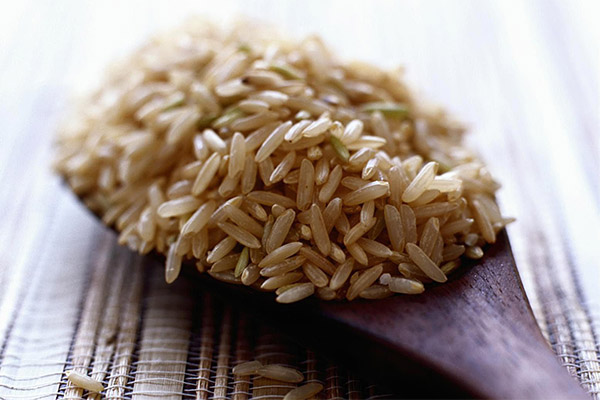
- Cleansing the body - removing toxins from the liver, freeing the intestines from toxins, normalizing the metabolism.
- Appetite control - eating nutritious food and deceiving the feeling of hunger.
- Reducing the caloric content of foods.
- Physical exercise and activity.
All of these points are easy to follow when eating brown rice:
- It cleanses the GI tract perfectly, improving absorption.
- Creates a feeling of fullness for several hours, allowing you to eat less.
- Saturates the body with the necessary substances to increase stamina, energy, and well-being.
- It removes excess fluid from the body.
- Improves the condition of the skin, maintains muscle tone, which is important when losing extra pounds and during detox.
- It improves blood flow and stimulates the burning of fat tissue.
Consuming brown rice as a diet product, you will be able to go through diets easier, without feeling bad, lethargy and irritability.
Experts recommend several variants of the brown rice diet.
- Detox after overeating. If you drank the night before or ate a lot of heavy food, you do not need to compensate for this by fasting the next day, because the body will need strength to restore the normal state and cleanse itself. You can resort to the rice diet. It is enough to eat a small portion of rice with vegetables for breakfast and for afternoon snack. This will act as a sorbent, cleanse the intestines and saturate the body with necessary elements.
- A cleansing day. Once every month or two, you can do a rice cleanse. Giving your body a little rest from digesting heavy fats, proteins and sweets, you will cleanse your blood and intestines, regain strength and feel lighter. On the day of the cleanse, you should eat only brown rice in small portions. Cook it without sugar and additives, with a small drop of quality vegetable oil. It is also possible to supplement the diet with herbal decoctions.
- There are also mixed diets, which include brown rice. They last for 3-7 days, after which time the product will need to be abandoned. Brown grains are combined with vegetables and fruits, steamed diet meats, eggs and beans. The cereal is introduced in different dishes, from first to dessert, and portions are calculated taking into account the balance of b/g/g and reducing the daily portion of calorie intake.
Patients with medical conditions should always consult a doctor before introducing new products into the diet to take into account all the individual nuances.
Brown rice in medicine
Official medicine treats brown rice neutrally and does not prohibit its consumption. Western and Asian nutritionists actively include it in weight loss and recovery programs for various diseases, because the product is light, rich in composition, and very palatable.
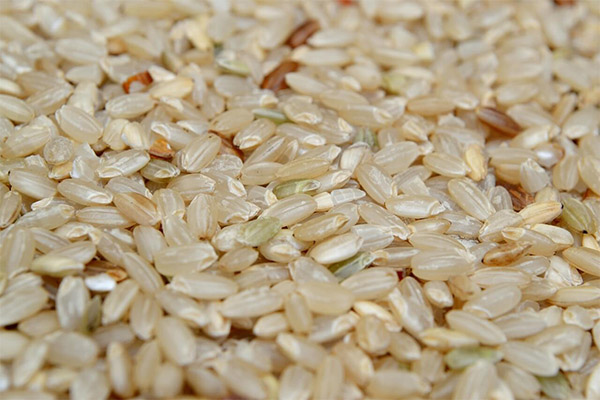
For diabetics.
For patients diagnosed with diabetes, brown rice can be an excellent substitute for high-calorie porridge. It helps to maintain normal sugar levels, combats cholesterol and promotes weight loss. Brown rice can not only be a side dish, but also replace unhealthy desserts: porridge with a delicate nutty flavor on honey (or without sweetener), with dried fruits and seeds will be a luxurious dish that will allow you to forget the hardships of food restrictions.
For pancreatitis
When pancreatic inflammation is usually prescribed starvation, and, to support the body, you can introduce a dietary diet of light brown rice. It is rich not only in carbohydrates, but also in useful amino acids and vitamins, so that the body will be easier to recover from an exacerbation of the disease.
To reduce the risk of deterioration, rice should be thoroughly soaked and boiled, after which you can grind the porridge in a blender. Such mashed potatoes will help to maintain the normal function of the gastrointestinal tract and not to overload the internal organs. Of course, the dish must be prepared without added sugar and fats.
With gastritis
Those who suffer from digestive discomfort due to gastritis should be very careful with uncooked rice. It is possible to consume the product, but it is necessary to boil it, grind it, combine it with milk and other soft components. It is better not to eat such rice often, so as not to provoke a worsening of the disease. It is possible to give preference to white rice, which will not bring any harm.
If you are constipated
People prone to the formation of hemorrhoids and constipation should not eat brown rice or should limit themselves to small portions. From diets built exclusively on brown product, you will have to give up, because it can give a fortifying effect: bind the stool and aggravate the situation. However, there is a loophole - consume brown rice with laxative foods: for example, make porridge with pumpkin or pear. Then the components will balance each other out.
For gout
Rice cereal is one of the allowed and even useful in gout due to its antioxidant and cleansing effect. It has no purines and other compounds that can provoke attacks. Brown rice, unlike the polished version, will help to cleanse the body faster and also contains significantly fewer calories. Naturally, you should cook such rice with dietary meat and greens, avoiding legumes, smoked meats, hot sauces, tomatoes and broccoli.
Folk medicine recipes based on brown rice
Brown rice grains are a useful cereal for preventing the development of many health problems. In what cases the properties of the product are used for treatment:
General cleansing of the body
Brown rice is excellent for cleansing the human body. The infusion is prepared as follows.
- It is necessary to pour 100 grams of rice for one liter of water.
- After this composition, previously covered with a lid, it is necessary to put on a slow fire for 40 minutes.
- Then the broth should be strained and cooled.
Take one third of a glass 1 time a day. The procedure should be carried out for 10 days. The medicine will normalize the metabolism and remove toxins from the body. At the same time it improves the composition of the blood and the performance of the liver.
To remove salt deposits in the joints
Rice grits are used to regulate the metabolism in the body. With its help, excess salts are removed from the joints, and bone tissue is protected from arthritis and arthritis.
The infusion is prepared as follows:
- Brown rice is taken and placed in 5 cups of two spoons each.
- The rice is poured with cold water, and the glasses are put away in a dark place.
- After one day the water is drained and fresh water is poured in. This procedure is carried out for 5 days.
- On the 6th day, rice from the first glass is boiled and eaten. In the first glass, new rice is poured and fresh water is poured.
- The next day, a similar procedure is carried out with the rice from the next glass.
According to this scheme, it is necessary to take the useful composition for 40 days. During this period, it is necessary to drink a lot of water and consume vegetables. This will contribute to the restoration of potassium in the body. The infusion is consumed in the morning. It will be possible to eat only after four hours.
It is necessary to know that rice has a serious effect on the human body, so the course of purification can be carried out no more than once every 12 months.
Harm and contraindications
It would seem that such an amazing and useful product should not have any contraindications, because it brings only good for the body. But this is not entirely true: brown rice is quite a heavy cereal because of its high content of dietary fiber and calories, so it should be eaten in moderation and monitor your well-being.
Some people are prone to constipation, gas and flatulence - in such cases brown rice should be included in the diet with extreme caution. Overeating porridge can not only bring excess calories, but also give a binding effect and cause bloating, especially in a loaded intestine.
Also keep in mind that brown rice requires careful handling. In order not to cause bran poisons or heaviness in the stomach, the grits are soaked and boiled well. This is especially important for the diet of the elderly and children.
Care should be taken in the consumption of people who suffer from the following ailments:
- GI diseases, gastritis, colitis;
- urolithiasis;
- Cardiovascular disease, hypertension and atherosclerosis.
In such cases, you need to seek guidance from your doctor: he will tell you if brown rice is okay for you and how to consume it without harm to your health.
How to cook brown rice: Recipes
To avoid harmful effects on the body and get a tasty dish with a pleasant and unlike anything else flavor, brown rice must be properly processed.
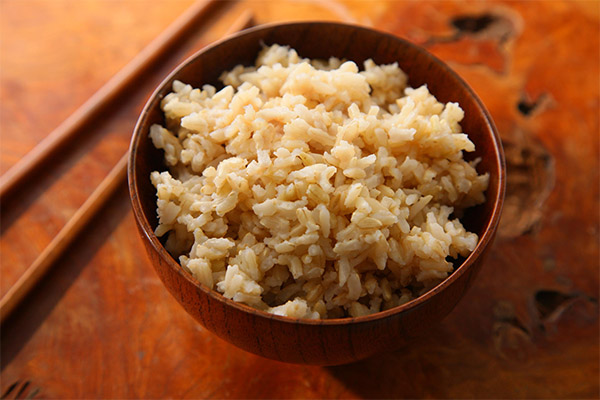
- First, the rice is soaked for a few hours, you can overnight, but 6 hours will be enough. This is done so that the rice softens and swells so that it cooks faster and tastes more delicate. But, in addition, it is necessary to soak the product to get out the toxic substances. In small amounts they are not harmful to the body, but a large concentration can cause symptoms of poisoning.
- After soaking, the rice is once again rinsed with running water and put on the fire. After boiling, you need to poach the groats for about 10 minutes, then drain the water again and rinse the rice from the kettle.
- Then the porridge is poured again and boiled for about another 20-35 minutes until it is ready. The drained rice is wrapped in foil or a towel right in the pot and let it finish. Only after that, oil and other fillings can be added to the groats. Salt, sugar and spices can be added during the cooking process, so that the grains are nourished from the inside.
The process seems laborious, but in fact there is nothing intimidating about it, and the result is a delight to even the most selective gourmets.
Because brown rice comes to us from Asian cuisine, we can find a lot of recipes for it with seafood, exotic berries and fruits, and spicy herbs. It combines well with cinnamon, badjan, cardamom and also excellently combines with garlic, different sorts of onions, aromatic vegetables, such as carrots, sweet peppers and even celery.
In dietary dishes, it is often cooked with vegetables and beans or meat products, as well as mushrooms to increase its nutritional value:
- corn, peas, nuts, beans, or soybeans;
- tuna, shrimp or crab, mussels;
- Oyster mushrooms and other kinds of mushrooms;
- Chicken, lamb.
It also combines with eggs and cottage cheese. However, tofu is used more often with brown rice. In addition, pieces of steamed or fresh fruits and berries, dried fruits, honey or maple syrup, and all kinds of nuts are often added to rice.
Boil the porridge with milk; for dietary purposes they usually choose coconut or almond products, but for children animal fats and calcium are important, so they take cow's milk.
Fresh salads based on lettuce, spinach, rucola, cabbage of different varieties, tomatoes, daikon or turnips are often added to a side dish of brown rice. It is not customary to use such rice in pie fillings or stuffing for cabbage rolls, but it would come in handy to stuff a squid with it.
To make a diet shake, take Greek yogurt, pieces of fruit such as apples, peaches, plums, grapes, strawberries, add some boiled brown rice, honey or sugar and whip in a blender. To make the smoothie more filling, you can add nuts and dried protein. Such a mixture for breakfast gives lightness, vivacity and a charge of strength for the whole day at work, and does not complicate physical training.
Hearty side dish ideas with brown rice
Asian pilaf is ideal: rice is stewed with pieces of chicken or seafood, adding carrots, celery, garlic and soy sauce. A honey-mustard gravy can also be made. Tomatoes, bell peppers, and hot peppers are added to roasts with lamb or beef. An appetizer with mushrooms is usually accompanied by lots of onions and seasonings to taste. Rice with fish is accompanied by carrots and lemon juice.
To prepare a hot appetizer, rice should be pre-cooked without salt, and then stewed with meat and vegetables, introducing components in the right order: meat first, then the tough vegetables, then porridge and spices, sauce.
For an ordinary side dish with vegetables it is enough to poach green beans or peas, leeks, peppers and other favorite components in a small amount of oil, add the rice and season with soy sauce, lemon juice and herbs. Diet rice is not fried, steamed pieces of vegetables are added and a drop of cold-pressed vegetable oil is drizzled over it.
You can make a delicious rice omelet by frying vegetables, mushrooms, adding porridge and pouring the dish with whipped eggs.
How to choose and store brown rice
Brown rice is a sensitive cereal that requires strict storage conditions. The fact is that ground rice becomes dry, but groats in the shells retain moisture, and this becomes a favorable environment for the development of fungi and bacteria. Therefore, the 2 main signs to pay attention to are the smell and dampness of rice. If the product begins to exude the smell of mold when stored at home, it will have to be thrown out, because even heat treatment will not clean such porridge. In the store, however, you should not buy wet rice with an unpleasant odor or a strange coating on the surface.

Also pay attention to important signs:
- The color of the rice should be light brown or reddish. Kernels that are too dark or light in color will indicate either counterfeit or that the product is spoiled.
- The size of the kernels should be about the same: all the rice grains should be of the same variety and crop.
- "Healthy" cereals have a fairly high cost, in addition, they are usually imported products. Today you can find them not only in health food stores, but also in regular grocery stores. And an inexpensive cereal with an uncertain appearance should raise doubts about its quality.
Store such rice in a tightly closed cereal jar, and in no case in an open bag. Many recommend to keep "live" rice in the fridge: so it will retain its valuable properties longer and will be protected from the environment.
Do not keep brown rice in the sun or outdoors. Organic oils are stored under the shell, which oxidize easily, triggering harmful processes in the grain.
Brown rice is not only a valuable potion for weight loss and wellness. Therefore, when weighing its benefits and harms, do not forget that it is just a delicious, unusual and savory snack that will bring a twist to a boring diet.
«Important: All information on this site is provided for informational purposes only purposes. Before applying any recommendations, consult a health care professional. specialist. Neither the editors nor the authors shall be liable for any possible harm caused by materials."


